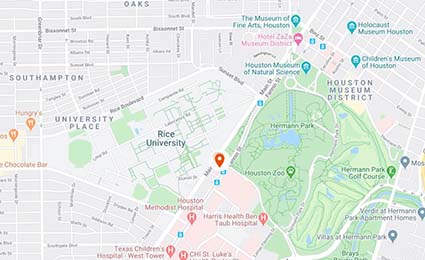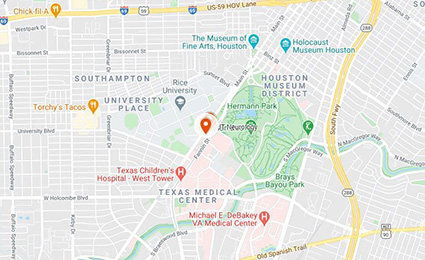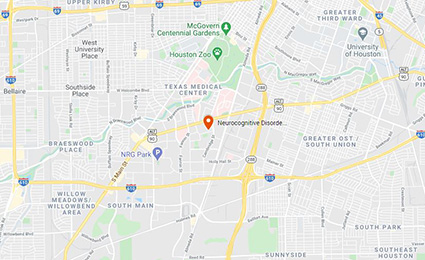Fall 2022 Pediatric Neuroscience Journal
With a $2.85 Million NIH Grant, Researchers Deploy Novel Technology to Study CSF Flow in Hydrocephalus Fluorescence cap-based transcranial optical tomography is helping physicians understand the role of CSF fluid flow dynamics in posthemorrhagic hydrocephalus. A special cap worn by the infant uses harmless nearinfrared light to study brain dysfunction, eliminating the need for anesthesia.
Strength in Diversity
At Children’s Memorial Hermann Hospital and UTHealth Houston Neurosciences, we pride ourselves on providing high-quality personalized care to young patients and their families with the utmost compassion, and we are honored to be recognized for our efforts in the 2022-2023 U.S. News & World Report Best Children’s Hospital rankings, one of the most prominent measures of achievement for any children’s hospital.
Children’s Memorial Hermann Hospital’s position as the pediatric teaching hospital for McGovern Medical School at UTHealth Houston ensures that the care we provide is based in teamwork among specialties and on the frontiers of medicine. It also underscores our commitment to research and education focused on improving the health and wellbeing of all children. Thanks to the collaboration between these two institutions, our program has attracted some of the top physicians and specialists in the world. They are highly trained and innovative, and are committed to providing compassionate care at the bedside and in the operating room. Through laboratory research and clinical trials, we bring discoveries to the bedside daily.
These are obvious strengths, but there’s another not-so-obvious strength – our program’s size.
With 332 beds, Children’s Memorial Hermann Hospital is large enough to offer the most advanced technology and healing expertise available, and small enough to ensure each of our patients a very personal care experience. The real story is told in the voices of our patients, and in this issue we honor five patients who were born with neurological conditions that make them different from other kids.
They have faced illness and disability heroically, with courage, tenacity, and a deep love of life. With the support of their families and friends, they have made remarkable recoveries or steady progress in their fight to live good lives. Our sincere thanks to Himanshu Prasad, Gracie Norman, Will Martin, EJ Dela Cruz, Luc Wehby, and their families for sharing their stories. Progress occurs when people dare to think differently, and that is the commitment we have made to the families we treat. The lives we’ve saved and our innovations through research have been made possible through the teamwork of our affiliated physicians and employees, our careful stewardship of the resources given to us, and our close partnership with the families who choose our program for their care.
We hope you find the articles in this issue of the Pediatric Neuroscience Journal useful in your practice – and that they prompt you to look at your patients in new ways. If you have questions about any of our programs, please contact us directly.
With best wishes,
David I. Sandberg, MD, FAANS, FACS, FAAP
Professor and Director of Pediatric Neurosurgery
Dr. Marnie Rose Professor in Pediatric Neurosurgery
Department of Pediatric Surgery and Vivian L. Smith Department of Neurosurgery
McGovern Medical School at UTHealth Houston
Director of Pediatric Neurosurgery
Children’s Memorial Hermann Hospital
Co-director, Pediatric Brain Tumor Program
The University of Texas MD Anderson Cancer Center
Gretchen Von Allmen, MD
Professor of Pediatric Neurology and Director of the Pediatric Epilepsy Program
Division Director, Child and Adolescent Neurology
Co-Director, West Syndrome Center of Excellence
McGovern Medical School at UTHealth Houston Medical Director, Pediatric Epilepsy Monitoring Unit
Children’s Memorial Hermann Hospital
Researchers Awarded $2.85 Million NIH Grant to Study New Technique Assessing Cerebrospinal Fluid in Babies with Hydrocephalus
A five-year, $2.85 million grant to use novel technology to study babies with hydrocephalus has been awarded to a team of UTHealth Houston researchers by the National Institute of Neurological Disorders and Stroke (NINDS), part of the National Institutes of Health. Co-lead investigators Eva M. Sevick, PhD; Manish N. Shah, MD; and Banghe Zhu, PhD, will deploy a new technique to understand the role cerebrospinal fluid flow dynamics play in posthemorrhagic hydrocephalus (PHH) with the goal of developing prevention, progression and treatment strategies.
Sevick is a professor and the Nancy and Rich Kinder Distinguished Chair in Cardiovascular Disease Research at The Brown Foundation Institute of Molecular Medicine for the Prevention of Human Diseases (IMM) at McGovern Medical School at UTHealth Houston. Shah is an associate professor of pediatric neurosurgery and the William J. Devane Distinguished Professor at McGovern Medical School, and Zhu is an assistant professor with the Center for Molecular Imaging at IMM. Shah also directs the Texas Comprehensive Spasticity Center at McGovern Medical School and the Pediatric Epilepsy Surgery Program at Children’s Memorial Hermann Hospital.
The optical imaging technique, called fluorescence cap-based transcranial optical tomography (fCTOT), involves the use of a wearable device developed two years ago by Sevick, Shah, and Zhu. The special cap for the infant’s head helps physicians study brain dysfunction with harmless near-infrared light, similar to the light used in a grocery store scanner, without requiring the patient to be under anesthesia.
The technique has been modified for the rapid, whole-brain fluorescent imaging of infants with PHH, allowing researchers to use indocyanine green (ICG), a safe green medical dye, to better track disordered cerebrospinal fluid flow (CSF) in patients with hydrocephalus.
“We hope to translate our basic science, engineering, and laboratory research in whole-brain optical imaging with fCTOT to the bedside to help our smallest patients in the NICU suffering from hydrocephalus,” says Shah, a pediatric neurosurgeon overseeing the care of patients with hydrocephalus at Children’s Memorial Hermann Hospital. “This grant will fund the first study ever to look at ICG in human CSF circulation and will specifically help answer the challenging question of which babies respond best to certain surgical interventions for hydrocephalus. In addition, the study will help establish fCTOT as a useful tool in an era of personalized medicine where we want to know how an individual patient may respond to novel treatments.”
Hydrocephalus affects 400,000 newborns globally each year. In developed nations, the primary complication of hydrocephalus is neonatal PHH – the progressive dilation of the ventricular system
that develops after neonatal intraventricular hemorrhage. It occurs in approximately 1 in 16 premature babies born at less than 29 weeks, and can lead to significant motor disability, developmental delay, and even death.
Specifically, PHH arises after bleeding occurs inside or around the ventricles of the brain. The bleeding causes an inflammatory response within the brain, disrupts cells involved in the production of cerebrospinal fluid, and potentially impedes the cerebrospinal fluid outflow into the lymphatics. As a result, the cerebrospinal fluid can become trapped in the brain’s ventricles, causing them to grow larger and ultimately manifesting as an unusually large head for the baby, along with developmental delays and disordered brain function. The buildup of CSF usually leads to excessive pressure inside the baby’s skull, requiring prompt neurosurgical treatment.
However, the medical field’s understanding of cerebrospinal fluid flow dynamics and outflow into the lymphatics is still incomplete and evolving, according to the researchers, hindering the development of improved strategies to prevent and treat PHH. “We are thrilled to be able to leverage our decades-long work in lymphatic flow imaging to study cerebrospinal fluid flow dynamics and its role in PHH,” says Sevick, who leads the Center for Molecular Imaging and is a faculty member of The University of Texas MD Anderson Cancer Center UTHealth Houston Graduate School of Biomedical Sciences. “PHH has a very limited number of treatment options at the moment, and we hope to give clinicians a new tool to assess which intervention is best for each patient and to potentially develop new strategies to better treat PHH.”
Sevick, Shah, and Zhu predict that in infants with PHH, impaired extracranial cerebrospinal fluid outflow into the peripheral lymphatics contributes to a vicious cycle of increasing neuroinflammation that may be responsible for initial treatment failures and progressive impairments that lead to irreversible brain injury. Through this study, the researchers hope to gain critical insights about cerebrospinal fluid flow dynamics in an effort to better treat patients with hydrocephalus, and potentially to avert the condition altogether.
“Our longstanding collaboration in CTOT and now in fCTOT, along with near-infrared imaging, has really paid off,” says Zhu, an optical engineer who translated the imaging technique for infants with progressing PHH. “This grant will help us demonstrate the state-of-the-art imaging capabilities we have developed here at McGovern Medical School and IMM to safely advance the care of these most precious patients.”
The study is funded by NIH award 1R01NS126437-01. Also assisting with the research is Amir M. Khan, MD, the David R. Park Professor in Pediatric Medicine and Richard Warren Mithoff Professor in Neonatal/Perinatal Medicine with the Division of Neonatology at McGovern Medical School and medical director of Children’s Memorial Hermann Hospital’s neonatal intensive care unit.
How a Breakthrough Neurosurgical Approach Helped Control Gracie Norman’s Epilepsy
Epilepsy is a family affair. Notoriously unpredictable, epilepsy and seizures disrupt the life of the patient and leave parents, siblings and other family members feeling helpless.
Read Gracie Norman’s story here »
A Good Life for Will Martin
If you search the internet for Leigh’s disease, or Leigh syndrome (LS), you’ll still find many websites that say that children born with LS die by the age of 2. Patients treated through the Leigh Syndrome Program at McGovern Medical School at UTHealth Houston and Children’s Memorial Hermann Hospital live much longer.
Read Will Martin’s story here »
Current Research in Mitochondrial Disease at UTHealth Houston
Mitochondrial diseases result from failures of the mitochondria, specialized compartments present in every cell of the body except red blood cells. Mitochondria are responsible for more than 90%
of the energy needed by the body to sustain life and support growth.
When they begin to fail, less and less energy is generated within each cell, ultimately leading to cell injury, and in some cases, cell death. If the process is repeated throughout the body, entire systems begin to fail, compromising the life of the patient. “It was only in the 1980s that we started recognizing the existence of mitochondrial disorders,” says Mary Kay Koenig, MD, professor and Endowed Chair of Mitochondrial Medicine, director of the Center for the Treatment of Pediatric Neurodegenerative Diseases and research director of the Division of Child and Adolescent Neurology in the Department of Pediatrics at McGovern Medical School at UTHealth Houston.
“Because children have a more severe phenotype, we tend to recognize it in them earlier. We’re beginning to see more diagnoses of adult-onset disorders, not because the incidence is increasing but because physicians are more educated about the disorders and are recognizing them. Diagnosis is just the first step. Now we have to develop proven treatments to help patients prolong their lives and improve its quality.”
Koenig is the UTHealth Houston site investigator for the following trials:
MOUNTAINSIDE: A Randomized, Double-Blind, Placebo-Controlled Adaptive Phase 2/3 Study with Open-Label Extension to Assess the Efficacy, Safety, and Tolerability of ASP0367 in Participants with Primary Mitochondrial Myopathy (0367-CL-1201)
Open to gadults age 18 to 80, the Phase 2 portion of this study will select a biologically active ASP0367 dose level and assess the safety and tolerability of the agent.
Phase 3 will assess the effect of the agent on functional improvement and fatigue relative to placebo.
STRIDE: A Double-Blind, Placebo-Controlled Study to Evaluate the Efficacy and Safety of 24 Weeks of Treatment with REN001 in Patients with Primary Mitochondrial Myopathy
Open to adults age 18 and older, this multicenter study will investigate the agent REN001 administered once daily for 24 weeks to patients with primary mitochondrial myopathy.
A Safety Study for Previously Treated Vatiquinone (PdddTC743) Participants with Inherited Mitochondrial Disease
Children, adults and older adults with inherited mitochondrial disease who have been treated with vatiquinione in a previous study are invited to enroll in this trial, which will continue until the drug becomes commercially available or the program is terminated.











